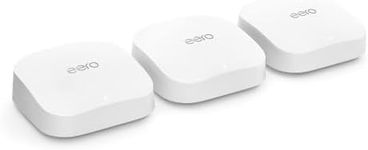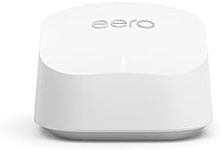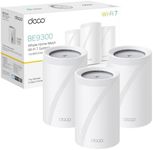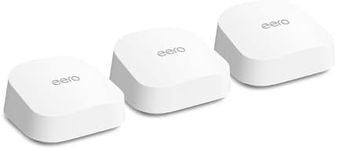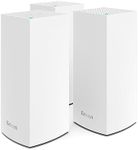Buying Guide for the Best Mesh Wi Fi Systems
Mesh Wi-Fi systems are designed to provide seamless internet coverage throughout your home or office by using multiple devices that work together to create a single, unified network. This is particularly useful in larger spaces or areas with many obstacles that can interfere with Wi-Fi signals. When choosing a mesh Wi-Fi system, it's important to consider several key specifications to ensure you get the best performance and coverage for your needs.Coverage AreaCoverage area refers to the maximum space that the mesh Wi-Fi system can effectively cover with a strong signal. This is important because it determines how well the system will work in your specific environment. Coverage is usually measured in square feet or meters. If you have a small apartment, a system with a smaller coverage area will suffice, but for larger homes or offices, you'll need a system that can cover more ground. Consider the size of your space and any potential obstacles like walls or floors that might affect signal strength.
Number of NodesNodes are the individual units that make up a mesh Wi-Fi system. The number of nodes you need depends on the size and layout of your space. More nodes can provide better coverage and eliminate dead zones, but they also require more setup and management. For a small home, two nodes might be enough, while larger homes or multi-story buildings might require three or more. Think about the areas where you need the strongest signal and choose a system with enough nodes to cover those spaces effectively.
SpeedSpeed refers to the maximum data transfer rate that the mesh Wi-Fi system can handle, usually measured in megabits per second (Mbps). This is crucial for activities like streaming, gaming, or video conferencing, which require high-speed internet. Systems are often categorized into different speed tiers, such as AC1200, AC2200, or AX3000, with higher numbers indicating faster speeds. Consider your internet usage habits; if you frequently stream 4K videos or play online games, opt for a system with higher speed capabilities.
Band SupportBand support indicates whether the mesh Wi-Fi system operates on single, dual, or tri-band frequencies. Dual-band systems use both 2.4GHz and 5GHz bands, while tri-band systems add an additional 5GHz band. More bands can help manage network traffic and reduce congestion, especially in busy households. If you have many devices connected to your network, a tri-band system might be beneficial. For fewer devices or less demanding usage, a dual-band system should be sufficient.
Ease of SetupEase of setup refers to how simple it is to install and configure the mesh Wi-Fi system. This is important for users who may not be tech-savvy or who want a hassle-free installation process. Some systems offer app-based setups that guide you through the process step-by-step, while others might require more manual configuration. If you prefer a straightforward setup, look for systems that emphasize user-friendly installation and management features.
Security FeaturesSecurity features are measures that protect your network from unauthorized access and cyber threats. This is crucial for safeguarding personal information and ensuring a secure browsing experience. Common security features include WPA3 encryption, automatic firmware updates, and parental controls. If security is a priority for you, choose a system that offers robust security features to keep your network safe.

